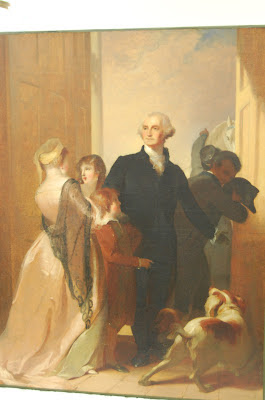The painting, a 30-inch by 25-inch oil on canvas by renowned
19th century American portraitist Thomas Sully, is entitled Washington and His Family. Washington
and His Family was completed by Sully in 1850 – 51 years after George Washington’s
death. The painting is in good condition
and depicts George Washington, Martha Washington and Washington’s two step-grandchildren
bidding him goodbye as he leaves for a trip.
In the background, two African servants assist Washington Washington
Thomas Sully was born in Horncastle , England London and briefly under Gilbert Stuart while
on a trip to Boston
Sully’s Washington and
His Family was given to the Washington Association of New Jersey in 1915 by
a private owner. Throughout the years it has had numerous cleanings and at
least two relinings. Records indicate
that the painting appears to have been relined and treated around 1979.
Back in August, Principal Conservator Daisy Craddock from Craddock
Painting Conservation Inc. surveyed Washington
and His Family to determine if the painting was in good condition for travel. Once the painting’s frame was removed, Craddock
examined the canvas under raking light. Raking
light involves illuminating the painting on an oblique angle to examine the
painting’s topography for any damages.
This method monitors the effects of prior conservation intervention,
makes it easier to see cupping paint (cup-like formations formed from aged
paint that becomes loose from cracking and has curled edges), and enables
uneven tension in a canvas to become visible.
While raking light, Craddock noticed cracks throughout the painting that
were slightly raised, but stable. She
suggested these cracks continue to be monitored.
Cracks appear when light is raked over the painting's surface.
The painting appeared to have a lot of retouching, which
Craddock attributed possibly to varnish.
Since varnish fluoresces under ultraviolet light (UVL), she hovered UVL
over the painting and noticed speckling on the top left corner from varnish
residue. Craddock said if varnish was
removed the painting would appear more vivid.
Additionally, she noticed blanching along the paintings small raised
cracks. Blanching occurs when varnish
has been damaged by water, degraded through age or partially dissolved with
solvents and has a white, clouded appearance.
Since varnish is soluble in acetone, Craddock removed a small area of varnish
with an acetone swab and noticed that retouching from prior conservators was
done well.
Craddock examines the painting under UVL.
Craddock swabs the varnish.
Overall, the painting was determined to be in good condition
and the lining was intact. However, the
painting’s frame is in poor condition.
While examining the carved wood gilded frame, Craddock saw extensive
stress cracking, active lifting and plaster losses. Several frame fragments even broke loose prior
to her visit. A framer will need to be
contacted before this valuable piece of Americana
Blog entry by volunteer, Maria Ribaudo.
Photos by volunteer, Steve Santucci.
Photos by volunteer, Steve Santucci.







No comments:
Post a Comment